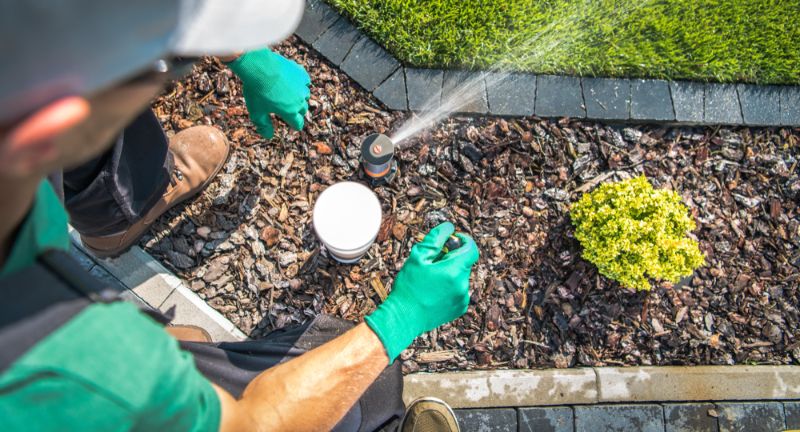LIFE
14 Tips For A Greener Lawn
Published
12 months agoon

Shutterstock
Maintaining a lush, vibrant lawn is a goal for many homeowners, but achieving and sustaining such greenery requires dedication and know-how. From proper watering techniques to strategic fertilization, there are numerous factors to consider in lawn care. By adhering to a set of essential tips, you can ensure your lawn remains healthy, green, and inviting throughout the seasons. These tips encompass everything from mowing practices to pest control methods, providing a comprehensive guide to lawn maintenance. With the right approach, you can cultivate a lawn that not only enhances your outdoor space but also contributes to a healthier environment.
Mow Regularly

Shutterstock
Keeping your lawn at an appropriate height through regular mowing is essential for its health and appearance. Different grass types have different ideal heights, but generally, maintaining it around 2.5 to 3 inches high is suitable for most grasses. Regular mowing also helps to stimulate grass growth and prevent weeds from establishing. Aim to mow your lawn when the grass is dry to achieve a clean cut and avoid tearing or damaging the blades.
Water Wisely

Shutterstock
Watering your lawn deeply but infrequently encourages deep root growth, making your lawn more resilient to drought and heat stress. Water your lawn early in the morning to minimize evaporation and fungal growth, and avoid watering during the hottest part of the day. Overwatering can lead to shallow root systems and increase the risk of fungal diseases, so it’s important to water your lawn only when necessary.
Practice Mulching

Shutterstock
Leaving grass clippings on your lawn after mowing can provide natural nutrients to the soil and help retain moisture, reducing the need for additional watering and fertilization. This process, known as mulching, also helps to improve soil structure and microbial activity, promoting overall lawn health. Mulching can save you time and effort while contributing to a greener and healthier lawn, so consider leaving those clippings where they fall during mowing.
Fertilize Properly

Shutterstock
Applying fertilizer according to your grass type and local climate is crucial for maintaining a lush, green lawn. Follow the recommended application rates and timings to avoid over-fertilizing, which can lead to nutrient runoff and environmental pollution. Consider using slow-release fertilizers to provide a steady supply of nutrients to your lawn over time, promoting healthy growth without the risk of burning or damaging the grass. Always water your lawn after fertilizing to help the nutrients penetrate the soil and reach the grass roots effectively.
Aerate the Soil

Shutterstock
Compacted soil can restrict root growth and water absorption, leading to thin and unhealthy grass. Aerating your lawn once or twice a year helps to alleviate soil compaction by creating small holes in the soil, allowing air, water, and nutrients to penetrate the roots more easily. This process promotes deeper root growth, improves soil structure, and enhances overall lawn health and resilience. Consider renting or purchasing a core aerator to aerate your lawn efficiently, especially if you have heavy clay soil or high-traffic areas.
Choose the Right Grass

Shutterstock
Selecting grass varieties that are well-suited to your climate, soil type, and sun exposure is essential for maintaining a green and healthy lawn. Consider factors such as drought tolerance, disease resistance, and maintenance requirements when choosing grass seed for your lawn. Conduct research or consult with a local lawn care expert to identify the best grass varieties for your specific growing conditions and preferences. By choosing the right grass for your lawn, you can ensure better performance, reduced maintenance, and long-lasting beauty.
Control Weeds

Shutterstock
Keeping weeds in check is essential for maintaining a green and lush lawn. Regularly inspect your lawn for weeds and promptly remove them by hand or using organic weed control methods. Avoid using chemical herbicides, as they can harm beneficial organisms and pollute the environment. Mulching, proper mowing, and maintaining healthy soil can also help suppress weed growth naturally, reducing the need for chemical intervention.
Test Soil pH

Shutterstock
Testing your soil pH periodically is crucial for understanding its acidity or alkalinity levels, which can affect nutrient availability to your grass. Most grasses prefer a slightly acidic soil pH ranging from 6.0 to 7.0 for optimal growth and nutrient uptake. If your soil pH is outside of the ideal range, you can adjust it by adding lime to raise pH or sulfur to lower it accordingly. Conduct soil tests every few years to monitor changes in soil pH and ensure your lawn’s continued health and vitality.
Provide Adequate Drainage

Shutterstock
Proper drainage is essential for preventing waterlogging and maintaining a healthy lawn. Ensure that your lawn has adequate drainage by grading it to direct water away from buildings and low-lying areas. Consider installing French drains, dry wells, or rain gardens to manage excess water and prevent pooling on your lawn. By improving drainage, you can reduce the risk of root rot, fungal diseases, and other water-related issues that can damage your lawn.
Reseed Bare Patches

Shutterstock
Bare patches in your lawn can be unsightly and invite weed infestations, so it’s essential to address them promptly. Fill in bare patches with grass seed to promote new grass growth and restore the appearance of your lawn. Choose high-quality grass seed that matches your existing lawn or select a new variety if needed to ensure uniformity in color and texture. Water the reseeded areas regularly and keep them well-moistened until the new grass establishes itself.
Avoid Heavy Traffic

Shutterstock
Minimize foot and vehicle traffic on your lawn, especially when the soil is wet, to prevent compaction and damage to the grass. Compacted soil restricts root growth and water absorption, leading to thin and unhealthy turf. Consider creating designated pathways or installing stepping stones to redirect traffic away from sensitive areas of your lawn. By reducing heavy traffic, you can preserve soil structure, promote healthier grass growth, and maintain a greener lawn.
Monitor for Pests and Diseases

Shutterstock
Regularly inspect your lawn for signs of pest infestations and diseases, such as discolored patches, thinning grass, or chewed blades. Identifying and treating these issues early can prevent them from spreading and causing extensive damage to your lawn. Use organic pest control methods whenever possible to minimize harm to beneficial organisms and avoid chemical pollution. Proper lawn maintenance practices, such as mowing at the correct height and watering deeply but infrequently, can also help strengthen your lawn’s resistance to pests and diseases.
Practice Organic Lawn Care

Shutterstock
Using organic lawn care practices can promote a healthier lawn and reduce your environmental impact. Opt for natural fertilizers, compost, and soil amendments to provide essential nutrients to your grass without the risk of chemical runoff. Incorporate organic pest control methods, such as beneficial insects, companion planting, and cultural practices, to manage pests and diseases naturally. By prioritizing organic lawn care, you can create a safer and more sustainable environment for your family, pets, and local ecosystem.
Regular Maintenance

Shutterstock
Consistent maintenance is key to keeping your lawn green and healthy year-round. Stay on top of regular lawn care tasks, such as edging, trimming, and cleaning up debris, to maintain a neat and tidy appearance. Remove leaves, branches, and other debris from your lawn regularly to prevent them from smothering the grass and blocking sunlight. By investing time and effort into regular maintenance, you can enjoy a lush, green lawn that enhances your outdoor space and improves your property’s curb appeal.
Conclusion

Shutterstock
Maintaining a green lawn is not just about aesthetics; it’s also about creating a healthy outdoor environment for you and your family to enjoy. By following these tips for green lawn care, you’re not only enhancing the beauty of your property but also contributing to the overall well-being of your local ecosystem. Remember, consistency is key in lawn maintenance, so make sure to incorporate these practices into your regular gardening routine. With proper care and attention, your lawn can serve as a vibrant oasis for relaxation and recreation for years to come. Here’s to a greener, healthier lawn and a more sustainable future!
Related Topics:

More From Lifestylogy
-


Oprah Winfrey’s New Show Gives Fans a Rare Glimpse at…
-


Oprah Shares Mudslide Video of her Santa Barbara Home
-


Is This The Most Hated Retail Store in America?
-


26 Reasons Everyone Should Be A Server A Least Once…
-


26 Dirtiest Jobs In The World, Would You Brave One…
-


Bedroom Hacks That Help Achieve the Perfect Sleep
-


Jenna Bush Hager Welcomes Baby Boy!
-


Chrissy Teigen and John Legend Welcome Baby Boy
-


Prince Harry to Reportedly Take Paternity Leave